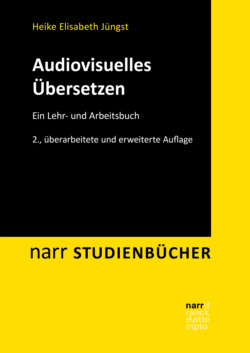Читать книгу Audiovisuelles Übersetzen - Heike E. Jüngst - Страница 38
На сайте Литреса книга снята с продажи.
2.8 Anhang: Richtlinien
ОглавлениеEs war schon mehrfach von Richtlinien für die Untertitelung die Rede. Bei Rundfunkanstalten handelt es sich fast immer um Richtlinien zur Untertitelung für Hörgeschädigte. Diese finden Sie entsprechend im Anhang zu Kapitel 7. Untertitelungsfirmen haben Richtlinien für die interlinguale Untertitelung. Auch Forscher und Berufsverbände beschäftigen sich mit diesem Thema und entwerfen Richtlinien. Existierende Richtlinien sind nicht in Stein gemeißelt. Neue wissenschaftliche Erkenntnisse und veränderte Sehgewohnheiten des Publikums haben einen Einfluss auf die Gestaltung von Richtlinien.
Die ESIST (European Association for Studies in Screen Translation) hat einen Kodex für ihre Mitglieder aufgestellt, den „Code of Good Subtitling Practice“. Diese Richtlinien gehören zu den bekanntesten überhaupt. Im ESIST-Code wird nicht zwischen interlingualer und intralingualer Untertitelung unterschieden.
1 Subtitlers must always work with a (video, DVD, etc.) copy of the production and, if possible, a copy of the dialogue list.
2 It is the subtitler’s job to spot the production and translate and write the subtitles in the (foreign) language reputed.
3 Translation quality must be high with due consideration of all idiomatic and cultural nuances.
4 Straightforward semantic units must be used.
5 Where compression of dialogue is necessary, the result must be coherent.
6 Subtitle text must be distributed from line to line and page to page in sense blocks and/or grammatical units.
7 As far as possible, each subtitle must be semantically self-contained.
8 The language register must be appropriate and correspond with the spoken word.
9 The language should be (grammatically) ‘correct’ since subtitles serve as a model for literacy.
10 All important written information in the images (signs, notices, etc.) should be translated and incorporated wherever possible.
11 Given the fact that many television viewers are hearing-impaired, ‘superfluous’ information, such as names, interjections from the off, etc., should also be subtitled.
12 Songs might be subtitled where relevant.
13 Obvious repetition of names and common comprehensible phrases need not always be subtitled.
14 The in- and out-time of subtitles must follow the speech rhythm of the film dialogue, taking cuts and sound bridges into consideration.
15 Language distribution within and over subtitles must consider cuts and sound bridges; the subtitles must underline surprise or suspense and in no way undermine it.
16 The duration of all subtitles within a production must adhere to a regular viewer reading rhythm.
17 Spotting must reflect the rhythm of the film.
18 No subtitle should appear for less than one second or, with the exception of songs, stay on the screen for longer than seven seconds.
19 The number of lines in any subtitle must be limited to two.
20 Wherever two lines of unequal length are used, the upper line should preferably be shorter to keep as much of the image free as possible and in left-justified subtitles in order to reduce unnecessary eye movement.
21 There must be a close correlation between film dialogue and subtitle content; source language and target language should be synchronised as far as possible.
22 There must be a close correlation between film dialogue and the presence of subtitles.
23 Each production should be edited by a reviser / editor.
24 The (main) subtitler should be acknowledged at the end of the film (or if the credits are at the beginning, then close to the credit for the script writer).
25 The year of subtitle production and the copyright for the version should be displayed at the end of the film.
TECHNICAL ASPECTS
1 Subtitles should be highly legible with clear lettering and a font which is easy to read. The characters should have sharp contours and be stable on the screen.
2 The position of subtitles should be consistent, e.g.
centred for film applications;
left-justified or centred for TV and video applications²;
two-person dialogue in one subtitle should be indicated by a dash at the beginning of each line.
1 In video applications, character clarity can be enhanced by a drop shadow or semi-transparent or black box behind the subtitles.
2 In laser subtitling, sharp contours and removal of residual emulsion can be achieved by precise alignment of laser beam focus and accurate adjustment of power output.
3 In laser subtitling, the base line must be set accurately for the projection format of the film.
4 The number of characters per line must be compatible with the subtitling system and visible on any screen.
Due to the different viewer reading times and the different length of lines for TV/video and film subtitles, TV/video subtitles should be adapted for film application and vice versa. (January, 1998) (www.esist.org/Code.pdf)
Mit freundlicher Genehmigung von Jan Ivarsson und Mary Carroll, die den Code in seiner ursprünglichen Form erstellt haben (Ivarsson / Carroll 1998).
Ordnen Sie diese Richtlinien den einzelnen Aspekten des Untertitelns zu. Welche könnte man auch für andere Formen der audiovisuellen Übersetzung übernehmen?
Bei einer solchen Liste ergeben sich Überschneidungen mit einem generellen berufsethischen Kodex für Übersetzer (wie z. B. beim BDÜ, dem Bundesverband der Dolmetscher und Übersetzer).
